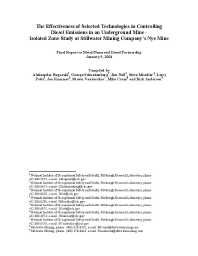Mining Publication: The Effectiveness of Selected Technologies in Controlling Diesel Emissions in an Underground Mine: Isolated Zone Study at Stillwater Mining Company's Nye Mine
Keywords:
NOTE: This page is archived for historical purposes and is no longer being maintained or updated.
Original creation date: January 2004
The objective of this study was to determine the in-situ effectiveness of the selected technologies available to the underground mining industry for reducing particulate matter and gaseous emissions from diesel-powered equipment. The protocol was established to determine the effectiveness of those technologies in an underground environment under operating conditions that closely resemble actual production scenarios.
Authors: AD Bugarski, GH Schnakenberg, JD Noll, SE Mischler, LD Patts, JA Hummer, SE Vanderslice, M Crum, R Anderson
Contract/MOA Report - January 2004
Final report to Metal/Nonmetal Diesel Partnership, Jan 5, 2004, http://www.msha.gov/01-995/dpmdocs/stillwater.pdf
See Also
- Aerosols Emitted in Underground Mine Air by Diesel Engine Fueled with Biodiesel
- Diesel Aerosols and Gases in Underground Mines: Guide to Exposure Assessment and Control
- Diesel Emissions Control Technologies in Coal Mines
- Diesel Emissions Control Technologies in Metal/Nonmetal Mines
- Diesel Exhaust
- Mutagenicity of Diesel Exhaust Particles from an Engine with Differing Exhaust After Treatments
- Real-Time Estimation of Elemental Carbon Emitted from a Diesel Engine
- Size Distribution and Deposition in Human Respiratory Tract: Particle Mass and Number
- Strategies to Reduce Miners Exposure to DPM and Gases (Elko)
- Technology News 514 - The Air Quantity Estimator (AQE): A New Computer Software Tool for Large-opening Mine Ventilation Planning
- Page last reviewed: 9/21/2012
- Page last updated: 9/21/2012
- Content source: National Institute for Occupational Safety and Health, Mining Program


 ShareCompartir
ShareCompartir
